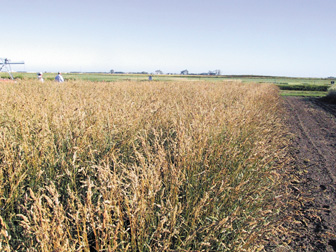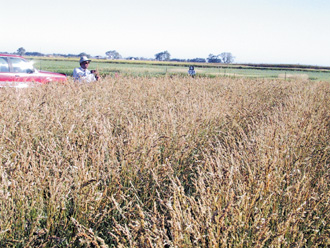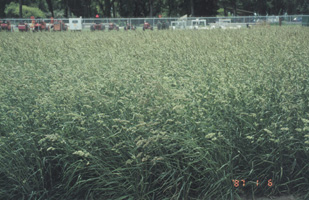
Features
Agronomy
Genetics/Traits
Winter-hardy orchardgrass
It could have been called Survivor Lethbridge. A new winter-hardy selection process votes out the weak and keeps the toughest, tastiest and most prolific orchardgrass varieties.
November 27, 2007 By Helen McMenamin
The many benefits of orchardgrass have always been eclipsed by the lack of
winter-hardiness. However, the 2004 release of a new winter-hardy variety, with
a proposed name of Kayak, now makes orchardgrass a viable option for prairie
forage growers. The grass is palatable, very productive and, as a heavy nutrient
user, valuable for manured sites. But developing the variety was not easy.
 |
| Dr. Surya Acharya and technician Ron Dalton inspecting Kayak orchardgrass breeder seed plot at Lethbridge Research Centre – irrigation. |
Winter-hardy boot camp means Chinooks, jackhammers and deep freezes. Lethbridge
forage breeder, Surya Acharya, took a novel approach in selecting winter-hardy
germplasm for his new lines of orchardgrass. Kayak is the first of what Agriculture
Canada scientists hope will be several winter-hardy orchardgrass varieties.
"We developed a very destructive testing method," says Acharya. "The
plants that survived that treatment didn't survive because of their position
in the field or any other variable. They're truly more cold resistant."
Acharya and his team grew plots of Kayak and Chinook orchardgrass for three
years, allowing southern Alberta's Chinooks and cold temperatures to select
for hardy plants. Then in January, they dug up plants (using a jackhammer) and
brought them into the lab. The forage breeding team cut away roots and shoots,
leaving only the crown of each plant with about a centimetre of material on
each side of it. Samples of crowns, with only a paper towel to protect them
from the cold, were subjected to temperatures between -2 and -20 degrees
C, then potted and moved into a greenhouse. All the plants regrew from crowns
subjected to -2 degrees C, but very few survived the -20 degrees C
treatment.
This process identified the LT50, the temperature treatment at which half the
plants survived. The LT50 was between -12 and -14 degrees C, although
it was different in each of the three years Acharya made his parent plant selections.
"Cold-hardiness is greatly affected by summer and fall growing conditions,"
says Acharya. "Gradually falling temperatures before killing frosts allow
plants to develop maximum cold-hardiness. We wanted to compensate for that in
choosing our parental lines."
Acharya then chilled more crowns to the LT50 temperature and planted the survivors
in the field, numbering every plant to monitor its traits. For three years,
he checked plants for any agronomic weakness and sprayed out any plants that
did not meet his standards. Then he intercrossed survivors.
 |
| Dr. Surya Acharya inspecting Kayak orchardgrass breeder seed plot at Lethbridge Research Centre – irrigation. |
When he had collected seed of the selected plants, Acharya grew it out and
subjected the daughter plants to his chilling test and repeated it again the
following year. The selected plants were not allowed to produce seed until their
third year, so Acharya had time to look at the yield and digestibility of each
line as well as its winter-hardiness. He and the ruminant nutritionists at Lethbridge
used an artificial rumen to assess the digestibility of the grass in a system
that is as close to a grazing animal as possible.
"We now have lines that were within the top 10 percent for yield, digestibility
and winter-hardiness," says Acharya. "We hope some others will prove
themselves in the western regional trials and we'll have two more varieties.
"Kayak has the soft, highly digestible leaves that have made earlier orchardgrass
very palatable and digestible. In general, the fibre content (NDF plus ADF)
of orchardgrass is about the same as meadow brome.
"Part of the problem in developing winter-hardy orchardgrass is that the
grass breaks its winter dormancy very easily. This allows it to grow very quickly
in spring and after cutting, but it also puts it at high risk for winter-kill.
In these new varieties we've been able to select for cold-hardiness and fast
growth."
Kayak is very cold tolerant, but it cannot withstand ice. In some weather patterns,
especially common in Quebec, ice forms in the soil and crushes the roots and
crowns. Acharya has collected and crossed individual plants that have survived
those conditions and hopes to have some lines to put into trials starting in
2006 or 2007.
Productivity increases forage potential
Given enough nutrients and moisture, orchardgrass is one of the most productive
grasses available. It regrows rapidly after cutting and is very palatable whether
grazed or hayed. The grass is most productive and maintains its quality from
mid-summer until frost, the time when most forages lose quality and yield potential.
 |
| Kayak pre-breeder seed plot at Lethbridge Research Centre – irrigation. |
In 17 location years of testing across western Canada, Kayak yielded an average
of 9.373 tonnes dry matter per hectare (3.794 tonnes dry matter per acre) under
irrigation. Dryland forage yield averaged 6.341 tonnes dry matter per hectare
(2.56 tonnes dry matter per acre) over 28 location years in western Canada.
Concerns about nutrient loading of heavily manured soils highlight the ability
of orchardgrass to lower soil nutrient levels almost as rapidly as corn. It
has extensive roots that take up large amounts of nitrogen, lowering the risk
of nitrates percolating through the soil profile to put groundwater at risk.
Now that Acharya has developed a winter-hardy variety, with several others
in the testing process, forage growers have the opportunity to see how this
highly productive perennial grass fits into their forage production systems.